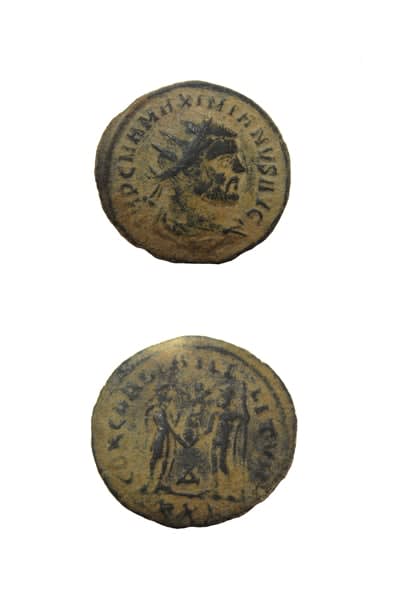Bronze Antoninianus of Emperor Maximianus, 286 CE - 305 CE
Bronze
LC.330
Obverse: IMP C M A MAXIMIANVS AVG; Radiate, Draped and Cuirassed Bust of the Emperor Facing Righ Reverse: CONCORDIA MILITUM; Maximianus Standing Right, Jupiter Standing Left Holding a Sceptre, Figure...
Obverse: IMP C M A MAXIMIANVS AVG; Radiate, Draped and Cuirassed Bust of the Emperor Facing Righ
Reverse: CONCORDIA MILITUM; Maximianus Standing Right, Jupiter Standing Left Holding a Sceptre, Figure of Victory Between; XXI (in exergue)
Born of humble parents, Maximianus rose in the army, on the basis of his military skill, to become a trusted officer and friend of the emperor Diocletian, who made him Caesar in 285 A.D. and Augustus the following year. Thus in theory, Maximianus became the colleague of Diocletian, but his role was always subordinate. Assigned the government of the West, Maximianus failed to suppress revolts in Gaul and Britain; Constantius Chlorus, appointed Caesar under Maximianus in 293, took charge of these areas while Maximianus continued to govern Italy, Spain, and Africa. On May 1, 305, the same day that Diocletian abdicated at Nicomedia, Maximianus abdicated, evidently reluctantly, at Mediolanum. As the new tetrarchy (two Augusti with a Caesar under each) that succeeded them began to break down, Maximianus reclaimed the throne to support his son Maxentius' claim to be Caesar. Persuaded to abdicate once more by Diocletian in 308, he lived at the court of Constantine, who had recently married his daughter Fausta. Maximian died in 310 shortly after the suppression of a revolt raised by him against Constantine.
Reverse: CONCORDIA MILITUM; Maximianus Standing Right, Jupiter Standing Left Holding a Sceptre, Figure of Victory Between; XXI (in exergue)
Born of humble parents, Maximianus rose in the army, on the basis of his military skill, to become a trusted officer and friend of the emperor Diocletian, who made him Caesar in 285 A.D. and Augustus the following year. Thus in theory, Maximianus became the colleague of Diocletian, but his role was always subordinate. Assigned the government of the West, Maximianus failed to suppress revolts in Gaul and Britain; Constantius Chlorus, appointed Caesar under Maximianus in 293, took charge of these areas while Maximianus continued to govern Italy, Spain, and Africa. On May 1, 305, the same day that Diocletian abdicated at Nicomedia, Maximianus abdicated, evidently reluctantly, at Mediolanum. As the new tetrarchy (two Augusti with a Caesar under each) that succeeded them began to break down, Maximianus reclaimed the throne to support his son Maxentius' claim to be Caesar. Persuaded to abdicate once more by Diocletian in 308, he lived at the court of Constantine, who had recently married his daughter Fausta. Maximian died in 310 shortly after the suppression of a revolt raised by him against Constantine.
